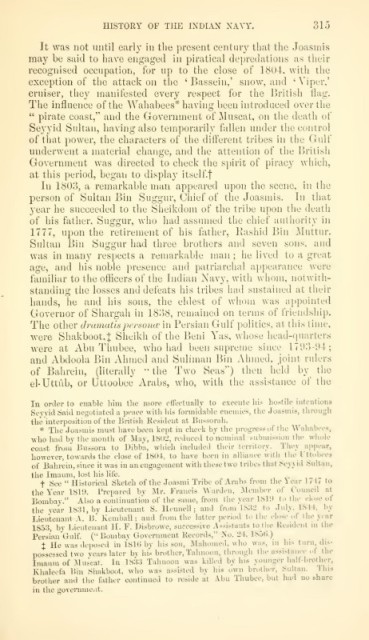Page 347 - INDIANNAVYV1
P. 347
HISTORY OF THE INDIAN NAVY. 315
It was not until early in the present century that the Joasmis
may be said to have engaged in piratical depredations as their
recognised occupation, for up to the close of 1804, with the
exception of the attack on the ' Bassein,' snow, and ' Viper,'
cruiser, they manifested every respect for the British flag.
The influence of the Wahabees* having been introduced over the
" pirate coast," and the Government of Muscat, on the death of
Seyyid Sultan, having also temporarily fallen under the control
of that power, the characters of the different tribes in the Gulf
underwent a material change, and the attention of the British
Government was directed to check the spirit of piracy which,
at this period, began to display itselff
In 1803, a remarkable man appeared upon the scene, in the
person of Sultan Bin Suggur, Chief of the Joasmis. In that
year he succeeded to the Sheikdom of the tribe upon the death
of his father, Suggur, who had assumed the chief authority in
1777, upon the retirement of his father, Rashid Bin Muttur.
Sultan Bin Suggur had three brothers and seven sons, and
was in many respects a remarkable man ; he lived to a great
age, and his noble presence and patriarchal appearance were
familiar to the officers of the Indian Navy, with whom, notwith-
standing the losses and defeats his tribes had sustained at their
hands, he and his sons, the eldest of whom was appointed
Governor of Shargah in 18o8, remained on terms of friendship.
The other dramatis im-sonce in Persian Gulf politics, at this time,
were Shakboot,:|: Sheikh of the Beni Yas, whose head-qiuirters
were at Abu Thubee, who had been supreme since 17i:K3-it4;
and Abdoola Bin Ahmed and Suliman Bin Ahmed, joint rulers
of Bahrein, (literally "the Two Seas") then held by the
el-Uttiib, or Uttoobee Arabs, who, with the assistance of the
In order to enable him the more effectually to execute his hostile intentions
Seyyid Said negotiated a yjeace witl> liis iormidable enemies, the Joasmis, through
the interposition of the British Resident at Eussorah.
* The Joasmis must liave been kept in check by the progress of the Wahabees,
•who had by the month of May, 1802, reduced to nominal submission tlie wiiolo
coast from Eussora to Dibba, wliieh included their territory. They appear,
however, towards the close of 1801, to have been in alliance with tlieUttobees
of Bahrein, since it was in an engagement with these two tribes that Seyyid Sultan,
the Imaum, lost his life. ^
" Historical Sketch of the Joasmi Tribe of Arabs from the Year 171/ to
t See
the Year 1819. Prepared by Mr. Francis Warden, Member of Council at
Bombay." Also a continuation of the same, from the year 181'J to tiui close of
the year 1831, by Lieutenant S. Heunell ; and from 1832 to July, 181-t, by
Lieutenant A. B. Kemball ; and from tlie latter period to tlie dose of the year
1853, by Lieutenant II. F. Disbrowe, successive Assistants to the Resident in the
(" Bombav Government Records," No. 24-, 1856.)
Persian G-ulf.
+ He was deposed in 1816 by his son, Mahomed, who was, in his turn, dis-
possessed two years later by his brutlier, TuhiK.oii, tlirough the nssistnncc of the
Imaum of Muscat. In 1833 Talmoon was killed by iiis younger half-brother,
Khaleefa Bin Sluikboot, who was assisted by his own brother, Sullan. Tins
brother and the father continued to reside at A.bu Thubee, but had no share
in the govemmciit.

